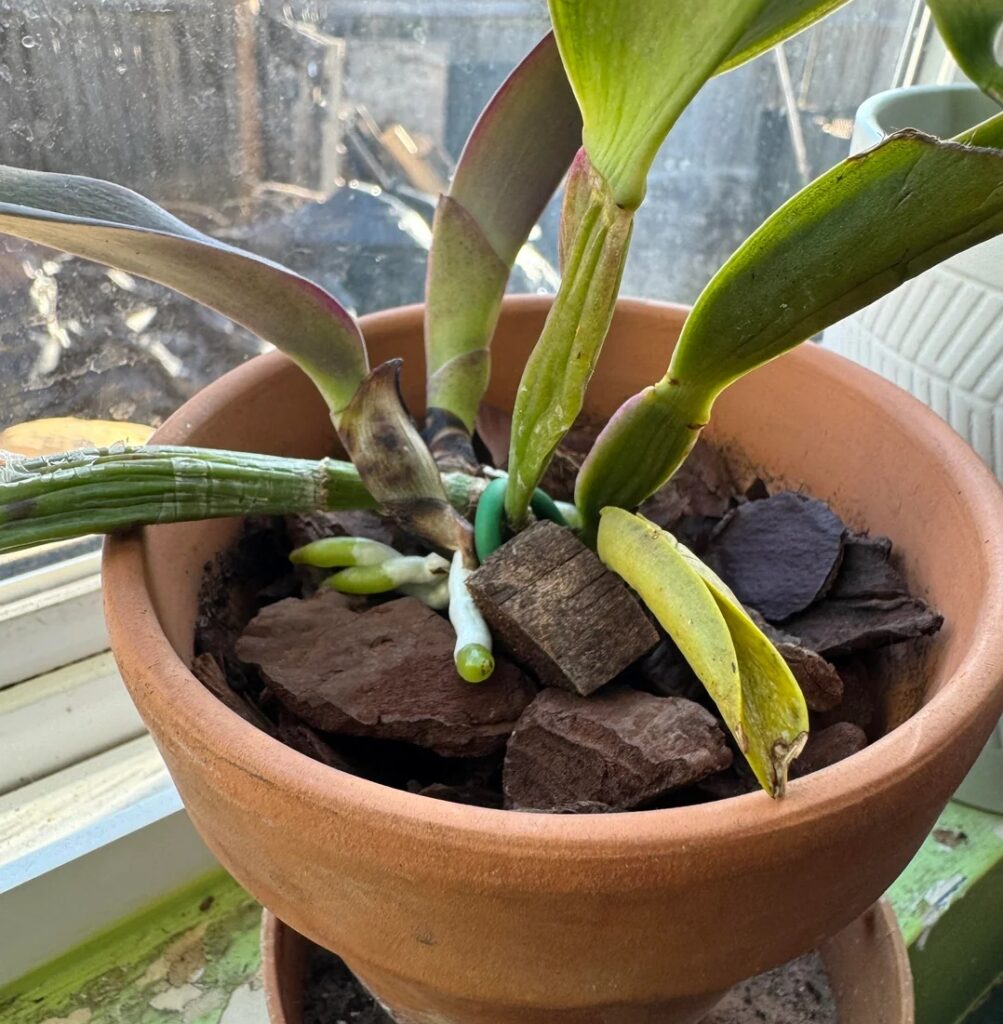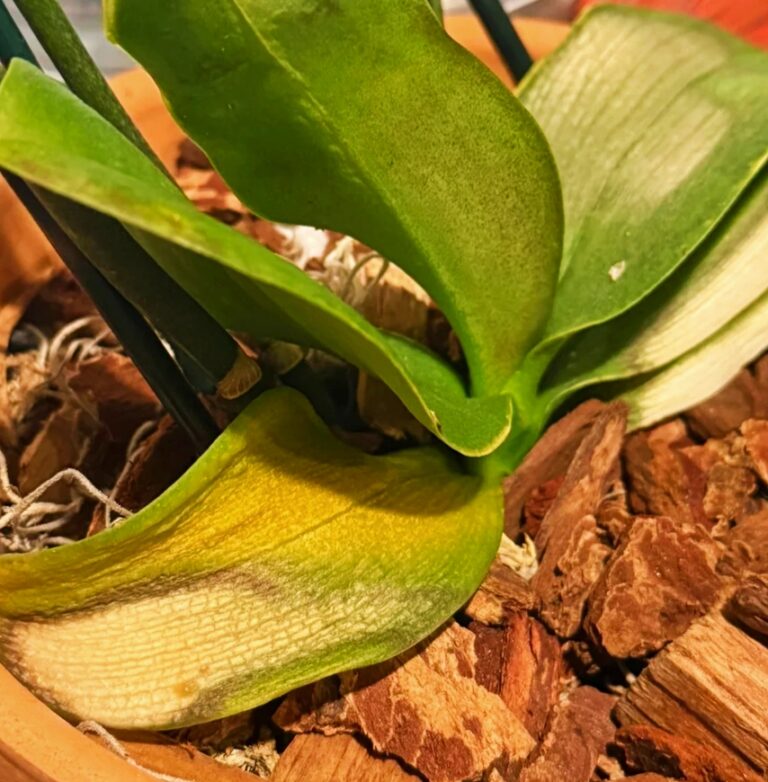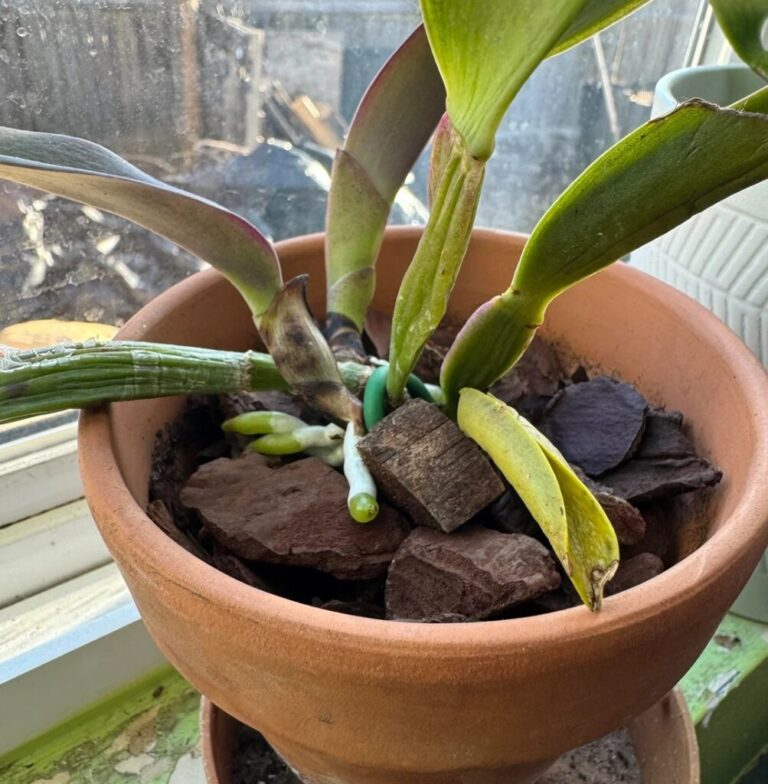Orchids are beautiful, delicate plants that require specific care to thrive. However, one common issue that many orchid growers face is leaf curling. If you’ve noticed your orchid’s leaves curling, don’t panic. This problem is usually a sign of environmental stress, improper care, or pest infestations. In this comprehensive guide, we will cover the ten best ways to fix orchid leaf curling and restore your plant’s health.

- 1 1. Check for Underwatering Issues
- 2 2. Avoid Overwatering
- 3 3. Ensure Proper Humidity Levels
- 4 4. Address Temperature Stress
- 5 5. Provide Adequate Light
- 6 6. Check for Pest Infestations
- 7 7. Fertilize Correctly
- 8 8. Repot When Necessary
- 9 9. Prevent Fungal and Bacterial Infections
- 10 10. Use the Right Potting Medium
- 11 Time Table for Fixing Orchid Leaf Curling
- 12 Conclusion
- 13 FAQs
1. Check for Underwatering Issues
One of the most common reasons for orchid leaf curling is underwatering. Orchids need a balanced amount of moisture to keep their leaves firm and healthy. When they don’t get enough water, the leaves begin to curl as a way to conserve moisture.
Solution: Water your orchid thoroughly once a week, ensuring that excess water drains out completely. The best way to check if your orchid needs water is to feel the potting medium.Watering is necessary if it is dry an inch below the surface.
Tip: Use rainwater or distilled water instead of tap water, as tap water often contains minerals that can build up and harm the roots.
2. Avoid Overwatering
While underwatering is a problem, overwatering can be just as harmful. Excessive watering leads to root rot, which prevents the orchid from absorbing water properly. As a result, the leaves may curl due to dehydration.
Solution: Always check the roots before watering. If they appear green and plump, your orchid has enough moisture. If they look silvery or shriveled, it’s time to water. Also, make sure your orchid is planted in a well-draining potting mix.
Tip: A clear plastic pot can help you monitor root health and prevent overwatering.
3. Ensure Proper Humidity Levels
Orchids thrive in humid environments. If the air in your home is too dry, the leaves may start to curl due to a lack of moisture in the air.
Solution: Maintain a humidity level of 50-70% around your orchid. You can achieve this by placing a humidity tray under the plant, using a room humidifier, or misting the leaves occasionally.
Tip: Avoid misting too frequently, as excess moisture on the leaves can encourage fungal growth.
4. Address Temperature Stress
Extreme temperatures can cause orchid leaves to curl. Orchids prefer stable temperatures between 65-75°F (18-24°C) during the day and slightly cooler temperatures at night.
Solution: Keep your orchid away from direct sunlight, cold drafts, and heating vents. Maintain a stable environment to prevent stress-related leaf curling.
Tip: If your home has fluctuating temperatures, consider using a thermostat to regulate indoor conditions.
5. Provide Adequate Light
Too much direct sunlight can scorch orchid leaves, causing them to curl and wrinkle. On the other hand, too little light can lead to weak, deformed growth.
Solution: Place your orchid in bright, indirect sunlight. East-facing windows are ideal for providing the right balance of light.
Tip: If natural light is insufficient, consider using grow lights to supplement the lighting conditions.
6. Check for Pest Infestations
Pests such as spider mites, aphids, and mealybugs can suck the sap from orchid leaves, causing them to curl and become deformed.
Solution: Check your orchid frequently for indications of pest activity. If you notice any, treat them with insecticidal soap, neem oil, or by wiping the leaves with a cotton swab dipped in rubbing alcohol.
Tip: Isolate infected orchids to prevent the spread of pests to other plants.
7. Fertilize Correctly
Over-fertilization or using the wrong type of fertilizer can lead to nutrient imbalances that affect leaf health.
Solution: Use a balanced orchid fertilizer (20-20-20) at half strength every two weeks. Avoid fertilizers high in nitrogen, as they can cause excessive leaf growth at the expense of flowers.
Tip: Flush the potting medium with plain water once a month to remove any salt buildup from fertilizers.
8. Repot When Necessary
If your orchid is root-bound or the potting medium has broken down, the plant may struggle to absorb nutrients and water, leading to curling leaves.
Solution: Repot your orchid every 1-2 years using fresh orchid bark or sphagnum moss to ensure healthy root growth.
Tip: Spring is the best time to repot orchids, as they enter an active growth phase.
9. Prevent Fungal and Bacterial Infections
Fungal and bacterial infections can cause leaf curling, yellowing, and spots on orchid leaves.
Solution: Keep your orchid’s environment clean and well-ventilated. If required, spray the plant with a fungicide and remove any diseased leaves.
Tip: Always sterilize your pruning shears before trimming orchids to prevent disease spread.
10. Use the Right Potting Medium
Orchids require a special potting mix that allows air circulation around the roots. Poor aeration can lead to root suffocation and, eventually, leaf curling.
Solution: Use a well-draining orchid mix that includes bark, perlite, and charcoal. Avoid soil-based potting mediums.
Tip: Choose a pot with drainage holes to prevent excess water retention.
Time Table for Fixing Orchid Leaf Curling
| Day | Task |
|---|---|
| Day 1 | Inspect the plant for pests, watering issues, and humidity levels. |
| Day 2 | Adjust watering schedule if needed. |
| Day 3 | Move the orchid to a suitable light location. |
| Day 4 | Check temperature and humidity, adjust if required. |
| Day 5 | Treat any pest issues if found. |
| Day 6 | Apply a balanced fertilizer. |
| Day 7 | Monitor changes and repeat the necessary steps. |
Conclusion
Orchid leaf curling is a common problem that can be fixed with proper care and attention. By ensuring the right watering habits, humidity levels, light conditions, and pest control measures, you can restore your orchid’s health and prevent further leaf curling issues. Consistency is key—regular monitoring and minor adjustments will go a long way in keeping your orchid thriving.
By following these ten best treatments, you’ll be able to enjoy lush, healthy orchids with beautiful, uncurled leaves. Keep an eye on your plant’s needs, and it will reward you with stunning blooms!
FAQs
What causes orchid leaf curling?
Orchid leaf curling can be caused by several factors, including underwatering, low humidity, excessive direct sunlight, over-fertilization, or pest infestations. When an orchid experiences stress due to any of these conditions, its leaves may start to curl inward or downward. Identifying the exact cause is crucial because different problems require different solutions. Checking the growing conditions, such as watering schedule, humidity levels, and light exposure, can help diagnose and fix the issue.
How does underwatering lead to orchid leaf curling?
When an orchid does not receive enough water, its leaves lose their natural firmness due to a lack of moisture. As a result, they begin to curl and wrinkle. This happens because orchids store water in their leaves, and when they become dehydrated, they try to conserve moisture by curling. To prevent orchid leaf curling due to dehydration, water your orchid consistently and ensure it receives enough moisture without letting the roots sit in standing water.
Can too much sunlight cause orchid leaf curling?
Yes, excessive direct sunlight can be a major cause of orchid leaf curling. Orchids naturally grow in shaded environments, such as under tree canopies, where they receive filtered light. If exposed to too much direct sun, the leaves can lose moisture rapidly, leading to curling, drying, or even sunburn. To prevent this, place your orchid in bright but indirect light, such as near a north or east-facing window, or use sheer curtains to diffuse strong sunlight.
Does low humidity contribute to orchid leaf curling?
Yes, orchids require a high-humidity environment to thrive, typically between 50-70%. When humidity levels drop too low, orchids struggle to retain moisture, causing their leaves to curl inwards as a protective mechanism. This is especially common in dry indoor environments with heating or air conditioning. To increase humidity and prevent orchid leaf curling, use a humidity tray, mist the leaves occasionally, or use a room humidifier.
Can over-fertilization result in orchid leaf curling?
Yes, over-fertilizing orchids can lead to salt buildup in the potting medium, which affects the roots and causes orchid leaf curling. Excess nutrients can damage the roots, making it harder for the plant to absorb water properly. To avoid this, always follow recommended fertilization guidelines—typically using a balanced orchid fertilizer at half strength once a week. Additionally, flushing the potting mix with clean water every month can help remove excess salts.
Are pests responsible for orchid leaf curling?
Pests such as spider mites, aphids, mealybugs, and thrips can damage orchid leaves, leading to curling. These insects feed on the plant’s sap, weakening the leaves and causing them to become deformed or distorted. If you notice tiny webs, sticky residue, or small insects on your orchid, take immediate action by using neem oil, insecticidal soap, or wiping the leaves with a diluted alcohol solution to eliminate the pests and stop the curling from worsening.
How can I prevent orchid leaf curling?
To prevent orchid leaf curling, provide the right balance of watering, humidity, lighting, and fertilization. Make sure the orchid is potted in a well-draining medium like bark or sphagnum moss, and water it according to its specific needs—typically once a week. Keep humidity at an optimal level, avoid exposing the plant to direct sunlight, and check regularly for signs of pests. Maintaining proper care and monitoring environmental conditions will help keep orchid leaves healthy and prevent curling.
Does repotting help with orchid leaf curling?
Yes, repotting can be beneficial if the orchid’s roots are unhealthy due to compacted or decomposed potting mix, which can lead to poor water absorption and orchid leaf curling. If you notice mushy or dry, shriveled roots, it’s time to repot your orchid into fresh, well-draining orchid bark or sphagnum moss. Repotting also allows better airflow around the roots, which helps in overall plant health and prevents leaf curling due to root stress.
Why do Phalaenopsis orchids experience leaf curling?
Phalaenopsis orchids, one of the most common orchid varieties, are particularly sensitive to low humidity and improper watering. If their environment is too dry or if they are underwatered, they will develop orchid leaf curling as a defense mechanism to reduce water loss. Ensuring a stable environment with proper humidity, watering, and indirect light will help keep Phalaenopsis orchid leaves smooth and healthy.
How long does it take for curled orchid leaves to recover?
The recovery time for orchid leaf curling depends on the severity of the issue and how quickly it is addressed. If the curling is due to temporary stress, such as dehydration, the leaves may start to improve within a few weeks once proper care is restored. However, if the damage is more severe, the curled leaves may not return to their original shape, but new growth should appear healthy with the right conditions.
Can using ice cubes cause orchid leaf curling?
Yes, watering orchids with ice cubes is not recommended, as the cold temperature can shock the roots, affecting their ability to absorb water properly. This stress can lead to orchid leaf curling and other health issues. Instead, water your orchid thoroughly with room-temperature water, allowing excess water to drain out completely to prevent root rot.
Does improper air circulation contribute to orchid leaf curling?
Yes, good air circulation is crucial for orchids. Without it, stagnant moisture can accumulate on the leaves, creating an environment for fungal infections, which can lead to curling or other deformities. To improve air circulation, keep your orchid in a well-ventilated area or use a small fan near the plant, ensuring that the air moves gently without causing excessive drying.
Why is only one leaf curling on my orchid?
If only one leaf is curling while others remain normal, it may be due to localized damage, such as physical injury, a pest bite, or exposure to an inconsistent watering pattern. It could also be an early sign of root stress, so inspecting the roots and overall plant health is recommended to prevent further issues.
Can genetic factors cause orchid leaf curling?
Some orchid species naturally have slightly curled or wavy leaves due to their genetic traits. While slight curling may be normal for certain orchids, drastic curling is usually a sign of environmental stress. If your orchid is otherwise healthy, slight curling may not be a cause for concern.
When should I worry about orchid leaf curling?
You should be concerned about orchid leaf curling if it is accompanied by other symptoms such as yellowing, brown spots, wilting, or mushy roots. These signs may indicate a more serious issue, such as root rot, fungal infection, or a severe pest infestation. If multiple leaves are curling and the plant looks unhealthy, it’s best to investigate the problem and take corrective measures as soon as possible.






